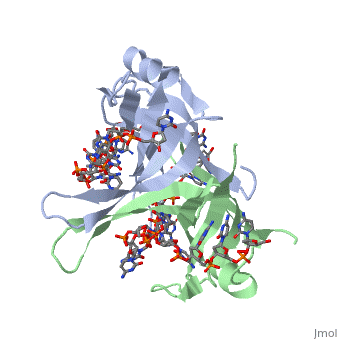Single stranded binding protein: Difference between revisions
Rachel Craig (talk | contribs) |
Rachel Craig (talk | contribs) No edit summary |
||
| Line 28: | Line 28: | ||
are found in a hydrophobic region, which is suitable for nucleotide base interactions. | are found in a hydrophobic region, which is suitable for nucleotide base interactions. | ||
==SSB-Protein Interactions== | ===SSB-Protein Interactions=== | ||
It is believed that Gly-15 may play an important role in binding the RecA protein. Mutations in Gly-15 have extreme effects on recombinational repair. SSB has also been thought to bind with exonuclease I, DNA polymerase II, and a protein n, which is used to help synthesize RNA primers for the lagging strand. | It is believed that Gly-15 may play an important role in binding the RecA protein. Mutations in Gly-15 have extreme effects on recombinational repair. SSB has also been thought to bind with exonuclease I, DNA polymerase II, and a protein n, which is used to help synthesize RNA primers for the lagging strand. | ||
Revision as of 01:37, 31 October 2013
Sandbox Single Stranded DNA-Binding Protein (SSB)Sandbox Single Stranded DNA-Binding Protein (SSB)
IntroductionThe single stranded DNA binding protein (SSB) of E. coli plays an important role in three aspects of DNA metabolism – namely in replication, repair and recombination. During DNA replication, SSB molecules bind to the newly separated DNA strands, keeping the strands separated by holding them in place so that each strand can serve as a template. SSB is also important for recombination because it promotes RecA protein binding.
StructureThe structure of SSB consists of a homotetramer that has a DNA binding domain that binds to a single strand of DNA.
|
| ||||||||||
Binding Interactions in the Active SiteBinding Interactions in the Active Site
Phe-60 is an important DNA binding site. It has been shown to be the site for cross-linking. Tryptophan and Lysine residues are important in binding as well. “Treatments resulting in modification of arginine, cysteine, or tyrosine residues had no effect on binding of SSB to DNA, whereas modification of either lysine residues (with acetic anhydride) or tryptophan residues (with N-bromosuccinimide) led to complete loss of binding activity” ( Meyer, 348). The two tryptophan residues involved in DNA binding are Try-40 and Try-54, which was determined by mutagenesis. One more binding site was determined by site-specific mutagenesis. When His-55 is substituted with Leu it decreases binding affinity. All of these residues are found in a hydrophobic region, which is suitable for nucleotide base interactions.
SSB-Protein InteractionsSSB-Protein Interactions
It is believed that Gly-15 may play an important role in binding the RecA protein. Mutations in Gly-15 have extreme effects on recombinational repair. SSB has also been thought to bind with exonuclease I, DNA polymerase II, and a protein n, which is used to help synthesize RNA primers for the lagging strand.
|
| ||||||||||
See AlsoSee Also
ReferencesReferences
PMID: 2087220
